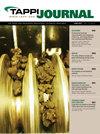Evaporation of lignin-lean black liquor
IF 0.6
4区 农林科学
Q4 MATERIALS SCIENCE, PAPER & WOOD
引用次数: 1
Abstract
Many of the pulp mill biorefinery concepts recently presented include removal of lignin from black liquor. In this work, the aim was to study how the change in liquor chemistry affected the evaporation of kraft black liquor when lignin was removed using the LignoBoost process. Lignin was removed from a softwood kraft black liquor and four different black liquors were studied: one reference black liquor (with no lignin extracted); two ligninlean black liquors with a lignin removal rate of 5.5% and 21%, respectively; and one liquor with maximum lignin removal of 60%. Evaporation tests were carried out at the research evaporator in Chalmers University of Technology. Studied parameters were liquor viscosity, boiling point rise, heat transfer coefficient, scaling propensity, changes in liquor chemical composition, and tube incrustation. It was found that the solubility limit for incrustation changed towards lower dry solids for the lignin-lean black liquors due to an increased salt content. The scaling obtained on the tubes was easily cleaned with thin liquor at 105°C. It was also shown that the liquor viscosity decreased exponentially with increased lignin outtake and hence, the heat transfer coefficient increased with increased lignin outtake. Long term tests, operated about 6 percentage dry solids units above the solubility limit for incrustation for all liquors, showed that the heat transfer coefficient increased from 650 W/m2K for the reference liquor to 1500 W/m2K for the liquor with highest lignin separation degree, 60%. Application: This study can be used to help assess the consequences for an evaporation plant concerning both changes in capacity and risk for fouling when evaluating a biorefinery concept, including lignin removal, at a mill. It also adds novel information to the research work on black liquor evaporation. Application: This study can be used to help assess the consequences for an evaporation plant concerning both changes in capacity and risk for fouling when evaluating a biorefinery concept, including lignin removal, at a mill. It also adds novel information to the research work on black liquor evaporation.木质素贫黑液的蒸发
最近提出的许多纸浆厂生物炼制概念包括从黑液中去除木质素。本研究的目的是研究木质素脱除过程中白酒化学变化对硫酸盐黑液蒸发的影响。从软木硫酸盐黑液中去除木质素,研究了四种不同的黑液:一种参考黑液(不提取木质素);两种木质素黑液,木质素去除率分别为5.5%和21%;其中一种木质素去除率最高可达60%。蒸发试验在查尔姆斯工业大学的研究蒸发器上进行。研究了液体粘度、沸点上升、传热系数、结垢倾向、液体化学成分变化和管结垢等参数。结果表明,由于盐含量的增加,低木质素黑液的结痂溶解度极限向低干固体方向变化。在105°C时,用稀液很容易清洗管上的结垢。结果表明,随着木质素用量的增加,浆液粘度呈指数下降,因此,传热系数随木质素用量的增加而增加。长期试验表明,所有白酒的传热系数从基准白酒的650 W/m2K提高到木质素分离度最高的白酒的1500 W/m2K,达到60%。应用:本研究可用于帮助评估蒸发工厂在评估生物炼制概念(包括木质素去除)时的影响,包括容量变化和污染风险。这也为黑液蒸发的研究工作提供了新的信息。应用:本研究可用于帮助评估蒸发工厂在评估生物炼制概念(包括木质素去除)时的影响,包括容量变化和污染风险。这也为黑液蒸发的研究工作提供了新的信息。
本文章由计算机程序翻译,如有差异,请以英文原文为准。
求助全文
约1分钟内获得全文
求助全文
来源期刊

Tappi Journal
工程技术-材料科学:纸与木材
CiteScore
1.30
自引率
16.70%
发文量
59
审稿时长
6-12 weeks
期刊介绍:
An internationally recognized technical publication for over 60 years, TAPPI Journal (TJ) publishes the latest and most relevant research on the forest products and related industries. A stringent peer-review process and distinguished editorial board of academic and industry experts set TAPPI Journal apart as a reliable source for impactful basic and applied research and technical reviews.
Available at no charge to TAPPI members, each issue of TAPPI Journal features research in pulp, paper, packaging, tissue, nonwovens, converting, bioenergy, nanotechnology or other innovative cellulosic-based products and technologies. Publishing in TAPPI Journal delivers your research to a global audience of colleagues, peers and employers.
 求助内容:
求助内容: 应助结果提醒方式:
应助结果提醒方式:


